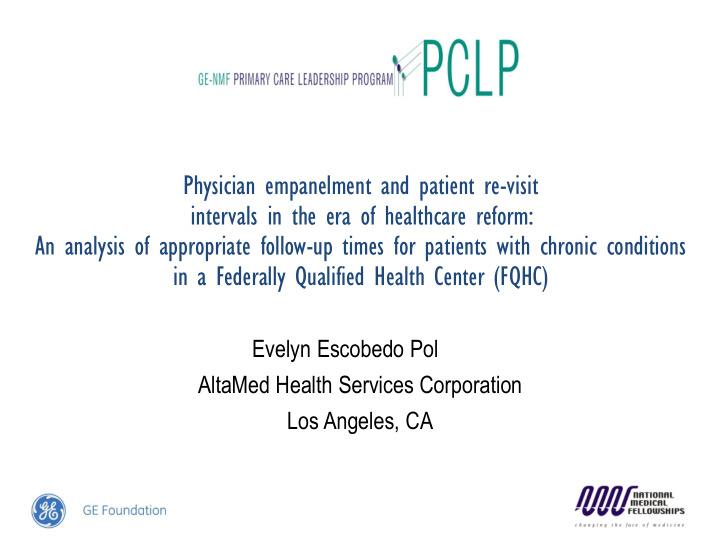



Physician empanelment and patient re-visit intervals in the era of healthcare reform: An analysis of appropriate follow-up times for patients with chronic conditions in a Federally Qualified Health Center (FQHC) Evelyn Escobedo Pol AltaMed Health Services Corporation Los Angeles, CA
Introduction • In an era of healthcare reform the number of individuals who historically have not had access to care, now have the access to preventative healthcare. • Patients now have opportunity to go to facility of their first choice. • Increased patient demand • Concern for access with increased pressure to reduce healthcare cost • Time?
Background • A substantial portion of outpatient office visits are follow-up visits. 1 • Frequency of follow-up intervals does not necessarily impact outcomes. 1 • Managing follow-up visit and intervals has potential to reduce costs per person and improve access without compromising or restricting care. 1 • Data indicate patient health status does not dominate physician follow-up visits, rather physicians appear to have characteristic scheduling tendencies that greatly influence the length of the revisit intervals. 2 • Postponing or prolonging the return-visit interval does not compromise quality, doing so can greatly increase the capacity to see more patients. 3 • Much work performed by primary care practitioners that does not require professional-level training could be delegated to team members. 3 Data from the 2009 Medical Expenditure Panel Survey found that young • adults ages 18 – 26 had the lowest health utilization rate of any age group. 4 Lack of access to health services and poor utilization contribute to low rates • of receipt of preventive health services in young adults. 4
Methodology • PubMed Search • Keywords in Search Engine: re-visit intervals, follow-up intervals, longitudinal care, physician panels, diabetes, hypertension, diabetes RVI (re-visit intervals) • Past 10 years • Data Collection: AltaMed • AltaMed Provider Survey • E-mailed link via Survey Monkey 5 questions • 1 week •
Results
Results Provider Survey Summary: What do you believe is the appropriate follow up interval for a patient with stable hypertension (<140/90)? 3 months: 23.73% 6 months: 52.54% What do you believe is the appropriate follow up interval for patients with stable hyperlipidemia (e.g. on a statin per new lipid guidelines)? 6 months: 57.63% 1 year: 28.81% What do you believe is the appropriate follow up interval for a patient with stable diabetes (e.g. HA1C < 7)? 3 months: 38.98% 6 months: 45.76% On a scale from 1-5 (1=very worried, 5=not worried), how worried would you be about increasing the follow up interval for your patients with stable diabetes by 1 month? (e.g. if you typically see such patients every 3 months, how worried would you be about increasing to every 4 months) 4: 33.90% 5: 35.59% If your patients with stable diabetes received a "check in" phone call/message/portal communication, would this help you feel more comfortable extending the follow up interval? (1=very helpful, 5=not helpful) 1: 30.51% 2: 28.81% 3: 16.95% 4:8.47% 5: 15.25%
Discussion • Stable uncomplicated hypertension: 6mo >1 yr • Stable and uncomplicated diabetes: there are no guidelines to support appropriate follow-up intervals • Stable and uncomplicated hyperlipidemia: there are no guidelines to support appropriate follow-up intervals • Implications for Further Study: • Guidelines for controlled Diabetes and Hypercholesterolemia re-visit intervals • Provide patient survey: do patients want to come in more often? • Do patient “check - in” calls impact quality of care?
Recommendations • Identify providers of highest utilizing patients with uncomplicated hypertension- what are the variables amongst them? • Tendencies to provide very high numbers of re-visits compared to expected levels provide clues for targeting education regarding practice guidelines and existing practice norms. 7 • Provide ongoing yearly provider guidelines/education seminar to maintain organization-wide baseline
References 1. Javorsky E, Robinson A, Boer kimball A. Evidence-based guidelines to determine follow-up intervals: a call for action. Am J Manag Care. 2014;20(1):17-9. 2. Schwartz LM, Woloshin S, Wasson JH, Renfrew RA, Welch HG. Setting the revisit interval in primary care. J Gen Intern Med. 1999;14(4):230-5. 3. Bodenheimer, Thomas and Pham, Hoangmai, H. Primary Care: Current Problems and Proposed Solutions. Health Affairs, 29, no. 5 (2010): 799-805. 4. Monaghan M. The Affordable Care Act and implications for young adult health. Transl Behav Med. 2014;4(2):170-4. 5. Bodenheimer T, Ghorob A, Willard-grace R, Grumbach K. The 10 building blocks of high-performing primary care. Ann Fam Med. 2014;12(2):166-71. 6. Murray M, Davies M, Boushon B. Panel size: how many patients can one doctor manage?. Fam Pract Manag. 2007;14(4):44-51. 7. Frohlich N, Cree M, Carriere KC. A general method for identifying excess revisit rates: the case of hypertension. Healthc Policy. 2008;3(3):40-8. 8. Schectman G, Barnas G, Laud P, Cantwell L, Horton M, Zarling EJ. Prolonging the return visit interval in primary care. Am J Med. 2005;118(4):393-9.
Acknowledgements • General-Electric National Medical Fellows Primary Care Leadership Program (GE- NMF PCLP) • Michael Hochman, M.D., M.P.H. • Ms. Tahira Hashmi • Ricardo Puertas, M.D. • Michael Rodriguez, M.D., M.P.H • Ms. Bessie Ramos • Mr. Davis Vickers • Ms. Melissa Dycus • Mr. Neal Noborio • AltaMed Health Services Corporation Providers
Recommend
More recommend